-
Posts
3,460 -
Joined
-
Last visited
Content Type
Profiles
Forums
Gallery
Events
Posts posted by amateur
-
-
Hi Alex,
Nice work so far!
Do you know the book by Heinrich Winter 'Hollandische Zweidecker 1660/1670'?
He gives quite a lot of pictures of a model of a Dutch two-decker. Dik has used the drawings from that book as a starting point for his recreation of the Zeven Provincien, and Mamoli clearly used the book as primary inspiration for the Friesland. The pics in the book may be helpful when it comes to the detailing of the decks.
Jan
- Bill Morrison, coxswain and J11
-
 3
3
-
Hi Marc,
making masts and spars from wooden dowels can also be done by hand.
gives you far more control on the resulting profile than using a machine.
There are quite a few threads in the 'wooden' buildlogs showing you the prces to get from square to octagonal to round.
I don't know how that was done in French ships, but for dutch ships of that period, the taper of masts and spars was not a 'straight' one: in profile, the masts and spars were kind of rounded, the thickest part not being at the bottom.
starting with a square dowel and doing the rounding by hand does give you the possibility to scribe the profile exactly on the wood, and make sure that it fits the regulations.
Jan
- popeye2sea, mtaylor, druxey and 2 others
-
 5
5
-
-
Ah well, three ships that are certainly not covered by the books you mention.....
I don't know anything on greek ships, I know that in Denmark there is a rather large literature on those drakar-like ships.
Google on 'skuldelev' and you will find loads of pictures of the reconstructed vikingships.
Pics give a rather nice view of the rigging and detailing of the ships.
Jan
-
Hi Matt,
as a very crude rule of thunb: yes.
in practice: depends.
I don’t know what model you are working on, but take a 17 century dutch ship: the diameters of all ropes are related to the size of the ship in a rathe complexsystem: the standing rigging relates to the size of the mast: the standing rigging of the mizzen is much thinner than on the main. Also: the standing rigging of the topmast is thinner than the lower mast.
The same holds to the running rigging: the larger the sail the thicker the ropes.
So: on each part of the mast the standing is thicker than the running, but the running rigging on the lower masts is way thicker than the standing rigging on the topmasts.
Besides: the thickness of the running rigging varies: the lifts are relatively thin, the sheets almost as heavy as the standing rigging.
following the formal rules, my Prins Willem shoukd have around 20 different ropesizes. Using around 8 sizes did result in a visually acceptable result.
Jan
-
5 hours ago, ErnieL said:
Oooh. I’m loving this!
You’re having a bad influence on me. I had to go dig through the stash, and found my old Artwox Varyag. Now I’m thinking about building microscale ships...
Did you see Joseph Lavender's models? That is some amazing micro-scale. Gregs models are huge compared to his. No Varyag, however.
Jan
- popeye the sailor, mtaylor, Canute and 1 other
-
 4
4
-
What a ship!
I like those early battleships, especially after the special treatment you give them.
(one question: did you use light grey/white thread for the rigging, or is it shiny as a result of the flashlight?). On the pics it looks so clean compared to al the dirt and rust.....
Jan
-
The 'real' Batavia has its wales natural.
Black can be quite heavy lookin. I prefer natural.
Jan
- drobinson02199 and Ondras71
-
 2
2
-
The ships boats were something of a battle.
There is no real instruction, so it is totally unclear whether the topside should go inside the hull, or on top of it. Either way: it wouldn't fit nicely.
The topside of the large boat was around 2 mm short, and put together, it does not sit properly on its stands....
Here is the result of a couple of hours. Bit frustrating
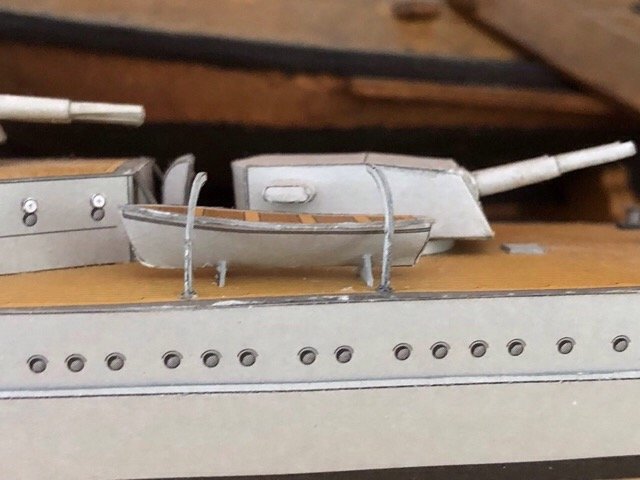
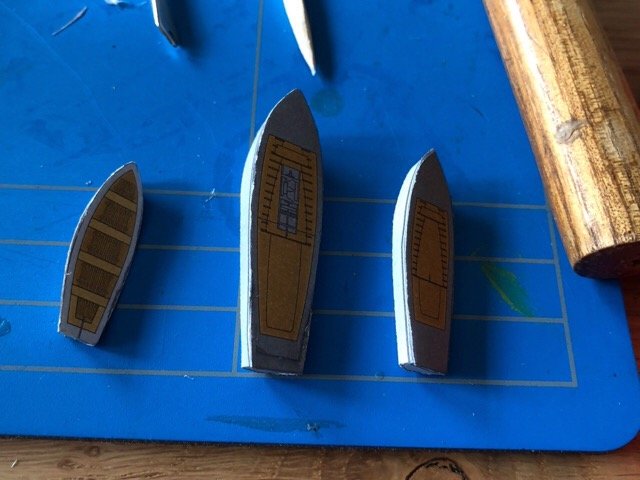
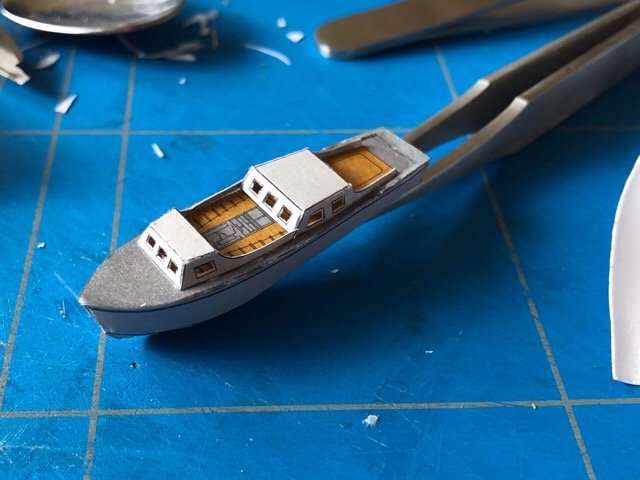
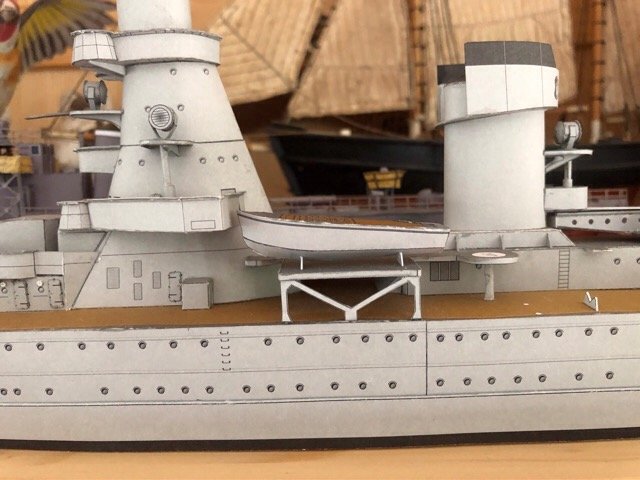
small remark: part of the boats were also in the lasercut-set. However, there the same (and some other) issues arose.
the lasercut (although sold to me together with the model itself) does not fit to the DeRuyter in grey. It is specifically designed on the other version: the one in 'dazzle'-paint.
In the macro-pics you can see one of the issues with the scaldis-models: when handled, the toplayer comes loose, resulting edges to loose their crispness.
you can see it on the edges of the boats: they become a bit 'fuzzy'
Jan
- mtaylor, lmagna, popeye the sailor and 3 others
-
 6
6
-
-
Now I am at a loss: what colour did the car have when leaving the factory: was it white, or black??
Jan
- mtaylor, Canute, Old Collingwood and 3 others
-
 6
6
-
-
Yes, those are clamps to hold the pins.
Jan
-
This kit was (loosely) based on a model in the Rotterdam Maritime museum,
https://www.maritiemdigitaal.nl/index.cfm?event=search.getdetail&id=100009961
(it is a shame that there are no high-resolution pics in this database)
and I guess some basic drawings dating back from the sixties. Lots of knowledge on fluits has build up since then, mainly due to the archeology, and better access to the archives.
So, when the kit diverges from the archeology, I would tend to follow archeology.
The winch is rubbish: the sides should be smaller, and if there are thoseextensions, they should be forwardfacing: thta is the direction in which they should withstand some force.
In some of the smaller wrecks, the whinch is going from side to side. I have also seen drawings (don't know where) with the heavy sides that enclose the winch.
As far as I know, the winch should be from one piece: no way to attach two parts in such a way that the thing does not break when force is applied.
In more modern fishingboats, (botters) as far as I know there are three types: round, octagonal, or round with some strips attached. The last two, to create aditional friction onto the cable.
there should be square holes in it, to get the lever in.
Jan
- ccoyle and flying_dutchman2
-
 2
2
-
West-frisian is a bit confusing terminology: in the Netherlands it refers to the northern part of North-holland, in Germany it ofter refers to anything west of their region Ost-friesland (wich is essentially the dutch provinces Groningen and Friesland).
It is not correct to say that the Dutch ended the political independence of west-friesland when you refer to the dutch region west-friesland. The word 'dutch' did not come into existence after the napoleontic era. Before that the netherlands consisted of a political union of various regions, holland being the most important. The political freedom of the kingdom of frisia ended in 1300.
The region around Hoorn.Schermer (the waling area) was part of Holland ever since the early middleages (the period were the zuijderzee became increasingly large). So if Frisian was ever the main language around Hoorn, it would have been around 1300, not around 1700. Around 1700 Dutch (which is essentially the dominant dialect spoken in holland) was standard in the western parts of the republic of the netherlands. The Frisian admirality operated from Harlingen (east side of the zuiderzee), and was a small admirality. The Frisian traders operated from Harlingen and Stavoren, and were mainly in the Baltic trade (wood and wheat)
Whalers came from Holland, and not from Frisia. Whaling industry was located in Holland, not in Frisia.
Jan
-
Could you please post a picture. I have some problem in getting the picture, and am afraid to advise you in the wrong way.
Jan
-
-
Actually, I didn't check that. Stern is the german translation I learned for the dutch wordt ster.....
I never heard noorden ster. Noordster and poolster are quite common.
I am not familiar with Frisian ( which is not a dialect, but a different language).
Dutch whalers came from the region north-holland (schermer/de rijp). Poolsterre would be the name to use.
@robert Lamba: where do you come from that you are familiar various dutch dialects, as well as flemish?
Jan
-
-
Nice little ship.
I downloaded some of the free ships, but still hesitating, as there are so many alomost invisible parts...
Although there is a nice Dutch monitor. Perhaps I will do that one.
Jan
- mtaylor and Edwardkenway
-
 2
2
-
I checked: in books on navigation around 1775/1800 they wrote about the poolsterre.
Both stern and sterne are german words. Couldn't find those in Dutchtexts.
Jan
-
Hi Dan,
the model of the Rex has been build by a rather famous shipbuilder. He knew what he was doing. As Dafi wrote: the slot in the upper deck has a cover (removable). The width of the slot is such that it remains just within the so-called schaarstokken: the heavy planks that are part of the main structure of the deck.
The length of the whipstaff coming through the upper deck is around 3 ft, too little to be handled from the top dedk, but exactly the length you need to pustthe whipstaff down to gain maximum rudder-angle.
and as both your and my drawings show: there is no need for a long slot: due to the fact that you push down the staff, the top of the staff goesunder the deck quite soon. Comparable, rather short slots can be seen on th epics of the HohenzollernModell and a model of a Dutch ship in Gent. They all suggest that the helmsman was not onthe uppereck, but one deck down.
It was not unttil the inteoduction of the steering wheel that the helmsman got to the upper deck again.
Jan
- Hubac's Historian, mtaylor, EJ_L and 2 others
-
 5
5
-
We had that discussion some time ago in a German forum. The opening in the upper deck is only to accomodate the overlenght of the whipstaff. The helmsmsn is down under, near the rowle. Ad you drew it: to get a reasonable rudder-angle , the opening in the upper deck should be enormous and thewhipstaff even longer. Doesn’t fit at all.
I sketched this one for the discussion in that other forum.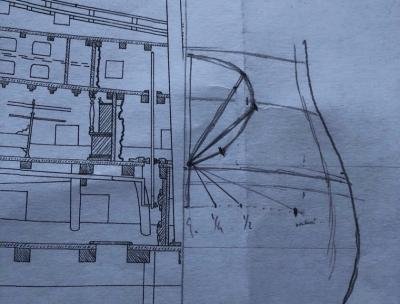
the end of the whipstaff goed under the upper deck even before half of the maximum rudderangle is reached.check the internet: the william Rex is a contemporeneous model: it shows a short opening on the upper deck.
Jan
-
Wouldn't call this 'little build': in cardterms this thing is really huge

Jan
- Egilman, Dan Vadas, Edwardkenway and 3 others
-
 6
6



New Young Model Builder from Minnesota LOOKING FOR ADVICE
in New member Introductions
Posted
Apart from all that has been said above:
You may want to take an other course for another reason: the plans from the (at least European) kits are hardly ever based on real drawings (especially the older shiptypes). And as they were made for static display-models, no one ever bothered about proper lines, stability, proper dimensions of the rig compared to the hull. As long as it looks right, it is right
So, perhaps you should start with drawings that are based on contemporary drawings of real ships, or on a drawing that has been mede especially for the 'sailing business': I know that for reasons of stability, it vcan be worthwhile to change the underwaterpart of your model, or add a keel of rather oversized dimension, just to prevent 'vasa-like' situatiuons at her maiden trip.
That brings me to a question (no experience in this line of business, but just wondering): Ik know a guy in a german forum turning out rather small models (scale around 1:40), which he can sail by RC. Mostly models of schooner-rigged type (as he states those are easier to sail, and therefore more fun). My point is: he needs quite an amount of lead into these models to get them stable sailing. (I rember something like 2 kilo's on a 1.5 ft long model), When you aim for 6 foot, all dimensions go by a factor 4. What does that do to the amount of lead you need on your keel (or how long does your external keel need to be, and how is sailability in not so deep water with such a lenghty keel?).
Jan